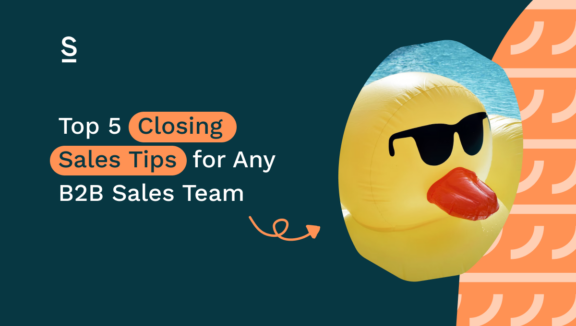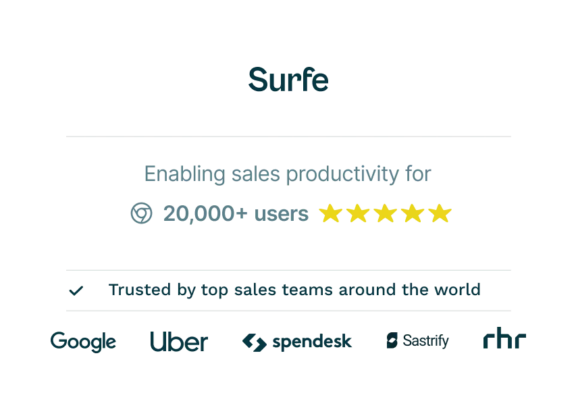Top 5 Closing Tips for Any B2B Sales Team

You’ve done all the hard work: you’ve found the perfect prospect with a budget and timeline that aligns with your sales strategy, got to know them through the discovery phase and pulled off a perfect demo call. But for some reason, you’re just not getting your prospect to commit to buying your product or service. You’re not alone. In fact, 36% of salespeople believe that closing the deal is the hardest part of their job.
A gap in your closing strategy can be the difference between you being a struggling SDR to a top performer. So, how can you fix your final moves to ensure your hard earned late stage prospect signs on the dotted line?
We’ve pulled together our top 5 closing tips for any team working in B2B sales that needs a little extra push to move your customers across the finish line.
In this article we’ll cover:
Closing Sales Tip 1. Create a Sense of Urgency
Creating a sense of urgency is a critical psychological driver in the sales process. It’s the catalyst that transforms hesitation into action, driving prospects to make decisions swiftly rather than delaying. Urgency taps into the fear of missing out (FOMO), prompting prospects to act immediately to avoid losing out on valuable opportunities. This can be especially vital in competitive markets where hesitation could mean losing to a rival.
Time-limited offers
One of the most effective ways to create urgency is through time-limited offers. These are promotions or discounts that are available only for a short period, pushing prospects to decide quickly. For example, offering a 20% discount on your SaaS subscription for the first 100 customers who sign up within the next 48 hours can spur immediate action.
Another tactic is to provide bonuses, such as complimentary onboarding services or exclusive access to premium features, but only if the prospect commits by a specific date. These strategies not only incentivize quick decisions but also add a layer of exclusivity to your offer.
Scarcity tactics
Leveraging scarcity involves highlighting the limited availability of your product or service. This can be done by emphasizing that only a few slots remain for a personalized demo, or that your software has limited licenses available due to high demand. By showcasing that the product might not be available later, prospects feel a heightened sense of urgency to secure their purchase now.
Closing Sales Tip 2. Build Internal Buy-in
Understanding the role of a champion
In the world of B2B sales, a customer champion is your secret weapon. This individual within the target company is an advocate for your product or service, influencing the buying decision from the inside. A champion believes in the value of what you’re offering and is willing to champion your cause to other stakeholders. They possess deep insights into the organization’s needs and dynamics, making their support crucial for navigating internal processes and overcoming objections. Essentially, your champion is your inside ally, driving your deal to the finish line. Our top closing sales tips for building internal buy-in are: value alignment and empowering the champion.
Value alignment
The first step in creating internal buy-in is aligning your product’s value proposition with the champion’s objectives and pain points. This means deeply understanding their role, challenges, and what success looks like for them. For instance, if your product offers a project management tool, emphasize how it can streamline processes, save time, and enhance productivity – directly addressing the pain points of a project manager. Tailoring your messaging to resonate with their specific needs ensures they see the direct benefits, making them more likely to advocate for your product internally.
Empowering the champion
Once you have a champion on board, it’s vital to equip them with the right tools and information to advocate effectively. Provide them with detailed case studies, ROI analyses, and tailored presentations that they can use in internal meetings. Offer training sessions or webinars to ensure they fully understand the features and benefits of your product. Additionally, crafting compelling messaging that highlights how your solution aligns with broader company goals can help them make a stronger case. By empowering your champion, you ensure they have everything they need to influence decision-makers positively.
Long-term benefits
Building strong internal buy-in doesn’t just help in closing the initial deal – it lays the foundation for a long-term partnership. A well-supported champion can make onboarding smoother, encourage higher user adoption rates, and help oversee a more successful implementation of your product. This strong internal buy-in sets the stage for future upselling opportunities and renewals.
When a champion continually reinforces the value of your product and is seen as integral to the organization’s success, it opens doors for expanding your footprint within the company. And when those happy champions move on to new roles or companies? You might just get brought along for the journey.
Closing Sales Tip 3. Execute a Flawless Follow-up Strategy
There’s no denying the power of follow-ups in B2B sales – when they are consistent and well-timed, they can turn a promising lead into a closed deal. But following up is not just about persistence; it’s about showing commitment and keeping the momentum going. A well-executed follow-up strategy ensures that your solution remains top-of-mind, addresses any lingering concerns, and helps guide prospects through their decision-making journey.
Timing and frequency
When it comes to follow-up timing, striking the right balance is crucial. Follow up too soon and you risk overwhelming the prospect; wait too long, and you might lose their interest. A good rule of thumb is to follow up within 24-48 hours after an initial meeting or proposal submission. After that, space your follow-ups at increasing intervals—such as a few days, then a week, then two weeks. This cadence keeps you in touch without being intrusive, allowing you to maintain a presence without seeming desperate.
Personalization
Generic follow-up messages are a surefire way to get ignored. Another useful closing sales tip is to tailor each follow-up based on your previous interactions and the specific needs of the prospect. Reference past conversations, address their unique pain points, and highlight how your solution specifically addresses their challenges. Sounds like a lot of extra legwork? Surfe’s personalized message templates for LinkedIn and InMail can save you hours of time by helping you create tailored templates for each of your customer segments that resonate with your prospect’s pain points.
Content and channel mix
The content of your follow-up messages should be varied and valuable. Share case studies that demonstrate success stories similar to the prospect’s situation, testimonials from satisfied clients, and ROI calculations that really demonstrate the financial benefits of your solution. Use a mix of communication mediums to keep the engagement dynamic. Start with an email, follow up with a call, and consider using LinkedIn for more casual check-ins. Each channel offers a different level of engagement, and using a combination can keep the dialogue fresh and engaging.
Measuring effectiveness
As with all business processes, you should use a test and learn approach to measure the efficacy of your follow-up strategy. Use CRM tools to monitor response rates, engagement levels, and conversion rates. Pay attention to which follow-up tactics elicit the best responses and adjust your strategy accordingly. If a particular type of content consistently receives positive feedback, incorporate more of it. On the other hand, if certain messages or timings aren’t resonating, make the necessary tweaks to improve performance.
Closing Sales Tip 4. Adopt an Assumptive Approach
Assumptive selling is a powerful technique that subtly guides prospects towards making a commitment by framing the sales conversation as if the decision to purchase has already been made. This approach leverages psychological momentum, helping prospects envision themselves as customers and making the final decision feel like a natural next step. By projecting confidence and certainty, assumptive selling reduces friction and accelerates the closing process.
Language and phrasing
The language you use in assumptive selling is crucial. It’s about subtly nudging the prospect towards a commitment through confident and forward-thinking phrasing. Here are some examples:
- Instead of saying, “Are you ready to proceed?” try, “When should we start the implementation?”
- Swap, “Would you like to schedule a demo?” with, “Let’s schedule your demo for next week. Does Tuesday or Thursday work better?”
- Replace, “Do you have any more questions?” with, “What questions do you have before we finalize this?”
This language assumes the sale is already decided, which can help the prospect feel more certain about moving forward.
Setting actionable next steps
Positioning the next steps as a natural progression of the conversation is a hallmark of assumptive selling. This technique transfers the decision-making burden onto the prospect, making the continuation of the process seem inevitable. For example:
- “Our next step is to get your team set up on the platform. I’ll send over the onboarding materials today.”
- “Let’s arrange a kickoff meeting with your key stakeholders next week to ensure a smooth transition.”
By outlining specific, actionable next steps, you guide the prospect towards commitment without directly asking them to make a decision.
Handling objections
Even for the most adept salespeople, last-minute objections can arise. A top closing sales tip is to handle these objections while maintaining your confidence and forward momentum. Here’s how:
- Acknowledge and address: “I understand you have concerns about the timeline. We’ve successfully managed similar implementations within your timeframe, and I’m confident we can do the same here.”
- Remind your prospect of the benefits: “I see your point about the budget. However, the ROI we’ve discussed shows that this investment will pay for itself within six months, significantly benefiting your bottom line.”
- Stay firm in being assumptive: “I can arrange a detailed plan to address your concern about integration. Shall we proceed with that so we can stay on track?”
Closing Sales Tip 5. Harness the Power of Personalized Plans and Pricing
Discounts and custom offers can be powerful tools for closing a deal, but proceed with caution before slashing your prices just to make a sale. Offering a discount too readily can devalue your product and signal to the prospect that there’s room to negotiate further. It’s essential to position discounts and custom offers as a final incentive, emphasizing the intrinsic value of your product throughout the sales process.
Tailored pricing plans
Creating customized pricing plans can be a game-changer for prospects with specific usage needs or budget constraints. Analyze the prospect’s requirements, and offer a pricing structure that aligns perfectly with their business model. For example, if a prospect’s business fluctuates seasonally, propose a flexible payment plan that scales with their usage. This tailored approach not only makes your offering more accessible but also demonstrates your willingness to collaborate and find mutually beneficial solutions.
Value-added offers
Instead of defaulting to discounts, consider value-added offers that enhance the overall package without reducing the price. Options include providing additional services such as premium support, extending trial periods, or bundling extra features at no extra cost. For instance, offering a three-month free trial of an advanced feature can add significant value and encourage commitment.
Protecting profitability
Flexible pricing can be a godsend in helping you seal the deal, but always keep the profitability of the account in mind. To ensure you don’t eat into your margin, our top closing sales tips for profitability are:
- Set Minimum Thresholds: Establish minimum purchase amounts or contract lengths to qualify for discounts. This ensures that the overall deal remains profitable despite the concession.
- Tiered Discounts: Implement a tiered discount structure where the percentage discount increases with the volume of purchase or length of commitment.
- ROI Focus: Always tie discounts and custom offers back to the expected ROI for the prospect.
Let’s Wrap it Up!
And that’s all there is to it – these top strategies are everything you need to empower your team and to encourage your customers to sign on the dotted line. By creating urgency, building internal buy-in, executing a flawless follow-up strategy, adopting an assumptive approach, and offering personalized plans and pricing, you’ll be well on your way to closing more deals.

Keen to close more deals?
Surfe’s personalized message templates for LinkedIn and InMail can help you send targeted outreach that really resonates with your prospects’ pain points.
Frequently Asked Questions (FAQs)
Why is closing so hard in B2B sales?
Last minute objections and complex sign off processes often disrupt late-stage sales. Without the right preparation, it can be hard to know how to handle unexpected roadblocks.
How can I improve my closing techniques for B2B sales?
Consider how you can use urgency tactics and discounts to help convince your prospects to buy from you.
What tools and technologies can I use to close more B2B sales deals?
Tools like Surfe can help you execute a flawless follow-up strategy by helping you create personalized message templates on LinkedIn and InMail, so you know your outreach is resonating with your prospect’s pain points.


